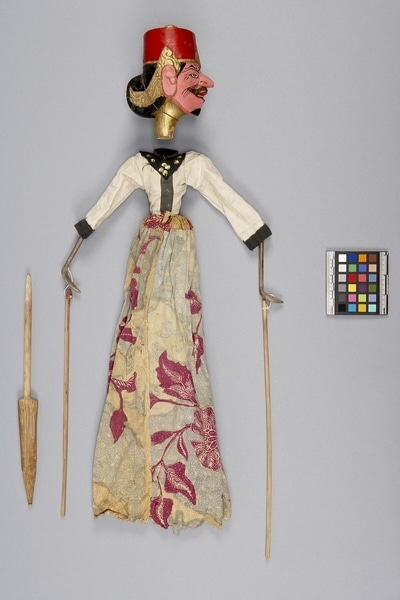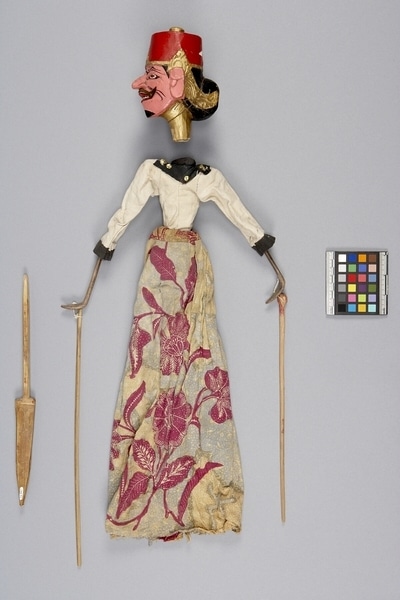Rod Puppet Item Number: Ib343 from the MOA: University of British Columbia


Description
A three-dimensional male humanoid figure puppet. Has a large head and jointed arms attached to controlling rods. The pink face is positioned forward with white eyes that have red irises. There are prominent white upper teeth, red lips, a beard, and other details in black. Brown material (felt ? synthetic ?) is tacked to the face as a moustache. The red cylindrical cap has gold top diadem (jamang), and sumping. Black hair net. Gold neck. The lower arms are brown (stained?) with the hands held flat and bending back at the wrist. The torso is covered in a beige tight-fitting garment with dark brown trim on cuffs, a yoke collar, and a shoulder overlay with fifteen gold-coloured sequins. String is tied around the headdress and the neck. A dark brown panel is on the front of the torso. Wearing a blue, purple, and yellow batiked skirt.
History Of Use
Javanese puppetry as an art form probably developed by the 11th century. Wayang golek puppets of western Java appeared during the 16th century. Originally the plays depicted Javanese mythology, but after the Indian conquest of Java the Hindu epics, Ramayana and Mahabharata, were incorporated into the cycles, which comprise about 200 plays. A dalang (puppet master) performs the plays to celebrate important occasions, usually in three acts, with vocal and instrumental accompaniment. Typically they serve a moral and religious purpose, and more recently, one of political commentary. Patih are political ministers or advisors, concerned with civil as well as military policy. They commonly give advice which is not taken. Sangkuni is known as an intelligent minister of great integrity and loyalty, who serves the Kurawa brothers in their unjust conflict against the usurped Pandawa brothers in the Mahabharata cycle.
Cultural Context
Theatrical performance.
Iconographic Meaning
Each puppet is characterized by it's wanda, a Javanese word which describes the specific mixture of elements of size, form, colour, ornamentation and carving. Pink face looking forward, red irises, exaggerated facial features and hair are negative qualities, usually indicating aggressiveness or lack of refinement. Garment suggests the role of minister or advisor (patih); headdress and tight-fitting garment suggest wealth or rank (of a low degree). Significance of string around head unknown. Batik skirt worn by noble characters. Headdress, shape of face and nose, and garments identify Sangkuni, a patih of the Kurawas.
Item History
- Made in Java, Indonesia
- Owned by Tradewind Antiques before March 15, 1983
- Received from Museum of Anthropology Shop Volunteers (Funding source) and Tradewind Antiques (Seller) on March 15, 1983
What
Who
- Culture
- Sundanese
- Previous Owner
- Tradewind Antiques
- Received from
- Museum of Anthropology Shop Volunteers (Funding source) and Tradewind Antiques (Seller)
Where
- Holding Institution
- MOA: University of British Columbia
- Made in
- Java, Indonesia
When
- Ownership Date
- before March 15, 1983
- Acquisition Date
- on March 15, 1983
Other
- Condition
- fair
- Current Location
- Case 61
- Accession Number
- 0886/0077